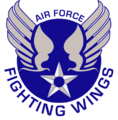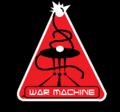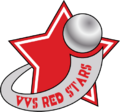Astroball
Astroball is a team space-based game, once described by a BNF in the VVS as "somewhere between quidditch, soccer, and demolition derby, and a hell of a lot of fun." It's based loosely on the game of the same name from the anime Stellvia of the Universe.
The object of Astroball is to score points by putting a one-meter ball into an opposing team's goal zone. One point is scored every time a player does this.
Rules
The game is played in a three-dimensional "field" one kilometer long and one-quarter kilometer wide and high. Thirty-five obstacles are allowed to drift randomly within the field (any that reach an edge of the field "bounce" back into the field). Five-meter-diameter goals are positioned in the centre "wall" of each long end of the field. One referee is present on the field, in a distinctive one-person ship.
Teams are made up of five players, each in a separate one-seat vehicle with with sufficient life support for a pilot (even if an AI is piloting the ship), a grav-grab on the front, and no weapons. (Hull armour or a forcefield has been strongly recommended ever since the end of the 2011 season, when the sport became full-contact, but smaller ships avoid obstacles more easily, and smaller ships don't have room for large power plants to move the armour around or power the forcefield.)
At the beginning of a half, or after a goal is scored, the players are arrayed in three lines on their half of the field. The line nearest the center of the field is made up of the forward and the flanker, who are expected but not required to play offensively. The second line is made up of the blocker and the fielder, who are expected but not required to play defensively and pass the ball to the forward or flanker. The third line is the goalie (who is not required to tend the goal).
Making contact with an obstacle or the referee's ship is forbidden, and results in a five-minute penalty for a first offense or expulsion from the game for a second offense. Making contact with an opposing player's ship is permitted.
The ball is manipulated with a ship's "grav-grab", a short-range gravity-effect device similar to (but weaker than) those used in the towing industry. Holding the ball for more than fifteen seconds is forbidden, and results in a two-minute penalty. Reversing the polarity of the grav-grab to throw the ball against an obstacle or the referee's ship and bounce it back to the same player is permitted, as is passing the ball to a teammate.
Games take place over 40 minutes, played in two 20-minute halves. The clock does not run when a penalty is being assessed or when the ball is being retrieved from a goal.
Venues
Both Starbase 1 and Stellvia maintain official Astroball stadiums. Stellvia's is the first Astroball venue ever constructed, and is open to anyone who wants to use it. (Reservations are strongly encouraged.) The Trekkies use theirs for Academy pilot training.
It doesn't take much to set up an Astroball field - just a few dozen obstacles, two goal zones, and some field boundary markers. This means any group with a couple of hundred credits to spare can set up a place to play the game.
Pickup games of Astroball have been known to take place in Saturn's rings, using the ice boulders as obstacles. The Fireflies still train there on a regular basis.
Astroball League
The Astroball League was founded in 2011 in an effort to get the game recognized as a Fennish-Olympic sport.
| What about the Wizards? |
| Hogwarts doesn't field an Astroball team; they're too busy playing quidditch. |
Match Play
The official Astroball season takes place in late-July and August, between baseball's All-Star Game and the North American Labor Day. The season is played round-robin style, with every team playing every other team once.
The two best teams at the end of the season compete for the Machida Cup[1] the week after Labor Day.
Off-Season
The rest of the year, a team will get together whenever convenient (or possible, in some cases) for training - honing piloting skills, developing new plays, coaching new players, and tightening up the team's timing.
Occasionally two teams will get together to play exhibition games during the off-season.
League Teams
As yet, there are no professional Astroball teams, because nobody has the resources to devote to a full-time team. These are recognized "semi-pro" teams, which have taken part in match play since the Astroball League was founded in 2011.
- Belt United.png
Belt United
- Fireflies.png
Fireflies
The "Original Four"
There were only four Astroball teams in 2011. All four still play today, and are recognized as the best teams in the League.
L5 All-Stations
League champions in 2011 and 2014
Team colors: orange and white
This is a mixed group from many of the Earth-Luna L5 stations; no one habitat had the manpower to field a team on its own in 2011. The five original stations of the L5 All-Stations were Stellvia, New Yavin, Abliarsec, Genaros, and Tsunami. Genaros dropped out in 2012, being replaced by Island One, and Tsunami rotated out in 2013 to make room for Central Station.
Two players have been on the team since its creation: forward Cal Calrissian from New Yavin and flanker Yayoi Fujisawa from Stellvia. (The original Abliarsec pilot left in late-2013 when he married his mechanic, but was replaced by another Ahb pilot.)
The team is funded by Stellvia.
Air Force Fighting Wings
League champions in 2012
Team colors: blue and silver
Based out of Benjamin Franklin Station and backed by the TSAB, the Fighting Wings are perhaps the most visible 'Dane group in Fenspace. Their truly professional piloting skills and habits (their forward and flanker are wingmen to each other, unlike most teams) are offset by the experimental equipment they are required to use by their superior officers. Their support crew has yet to develop a working hardtech drive or grav-grab, but that doesn't stop them from using Astroball games as test venues.
The Fighting Wings used 'waved jets - the largest vehicles ever to be used for Astroball - at the start of the 2011 season, but quickly realized their jets' bulk and profile were interfering with maneuverability.
Academy Cadets
League champions in 2013
Team colors: gold and blue
Backed by the Trekkies, the Cadets are a college team, based out of Starfleet Academy on Starbase 1. They are the only team to individually name their ships; they use shuttlecraft names from the various incarnations of Star Trek. (This keeps feuds over which Trekkies get to use "the good names" to a minimum; they're reserved for official use.)
Crystal Kyoto Knights
Team colors: silver and "rainbow" (there were too many arguments about which Sailor Senshi's color to use for the ships' highlights before they decided to use them all)
The Knights are funded by the Senshi and based out of Crystal Kyoto. They were originally an all-male team, but became co-ed in 2012.
| Kay and Yuri |
| The best-known Astroball announcers are Kay and Yuri Lischinsky, based out of Starbase 1. They usually cover Martian weather and Trekkie sports for the Federation News Service, but during the Astroball season, they put that aside and provide live color commentary for every game.
They're the sport's biggest fans, bar none. Kay and Yuri even capped off the 2012 season by getting married in the Starbase 1 Astroball stadium! |
Newcomers
The 2012 season saw five teams join the League, four of which continue to play today.
Banzai Institute Dragons
League champions in 2015
Team colours: blue and white
The League team for the Institute. Noted as being the best among the Blue Blazers (who have several intramural teams, based out of their various cities or colonies), the team roster changes often, with members being cycled out. It has more than the average number of second- and third-string players, many of whom do not sit on the sidelines during play, but only show up when first-stringers are pulled out due to Institute emergencies. Buckaroo takes players off of the Global Frequency during games, but will notify game officials and the team staff if a player is needed.
The Dragons are not known as a particularly consistent team, due to the other commitments of the Institute, but they always bring a certain amount of enthusiasm and esprit de corps to their games. The team focuses on teamwork, providing for some dazzling displays of astrobatics (the vacuum equivalent of aerobatics) and seemingly telepathic communication between players. (No psychic powers are involved, just an awareness of where teammates are or should be that has been finely honed.)
The Dragons all tie on a rising sun hachimaki under their safety helmets before entering a game. The hachimakis are duplicates of Buckaroo's own headband, as seen in The Adventures of Buckaroo Banzai: Across the Eighth Dimension and in the syndicated Fenspace television series.
Belt United
Team colors: green and yellow
A mixed group from the major Main Belt mining towns, based out of Ceres and backed by Rockhounds.
Fireflies
Team colors: brown and gray
The Fireflies are based out of Serenity Valley, Ganymede, and are an even mix of Browncoats and Juvies.
Kandor City Vigilantes
Team colors: dark gray and white
A pickup team sent to the big leagues in order to give the Lunar colonies somebody to root for other than the All-Stations, the Vigilantes are publicly owned by the citizens of Kandor City.
SOS-dan
Team colors: green and blue, with red lettering
The SOS-dan played in 2012 only. They had a disastrous first half-season, but the mid-season replacement of flanker Mikuru Asahina with Winry Rockbell at least salvaged the team's dignity. As the name implies, they were backed by the SOS-dan.
2013 Entrants
So far, two more teams have declared their intention to participate in the 2013 season. The League organizers are seriously considering lengthening the season to make time for all the round-robin games.
Martian War Machine
Team colors: red and black
Backed by the Mars Terraforming Project, the War Machine is based in Port Lowell and is composed of a mix of Pulpers and fendanes. They're noted for a particularly ruthless playbook (as befits their name).
VVS Red Stars
Team colors: red and silver
The first (and so far only) all-AI team in the League; the players in their day jobs are X-COM's infamous air combat patrol Azu Squadron. Based (reluctantly) out of Gagarin Crater AFB and backed (very reluctantly) by the Soviet Air Force.
The VVS Red Stars are the single worst team in the league; the squadron is too busy goofing around and showing off for the fans to actually play the game properly. As of the beginning of the 2016 season, the Red Stars have a worse win-loss record than the infamous 2012 SOS-dan team.
Stories
Astroball plays an important part in The 2012 Season.
Notes
- Jump up ↑ Apparently, Yayoi Fujisawa insisted on that name for the trophy. Nobody's sure why, since she's never so much as visited that part of Tokyo.








